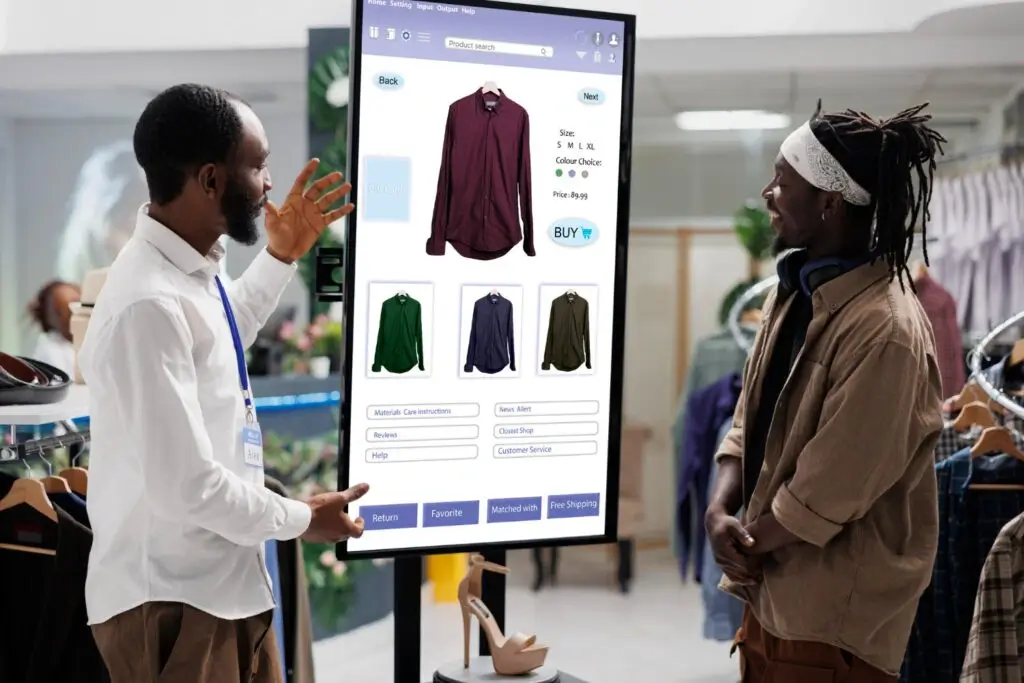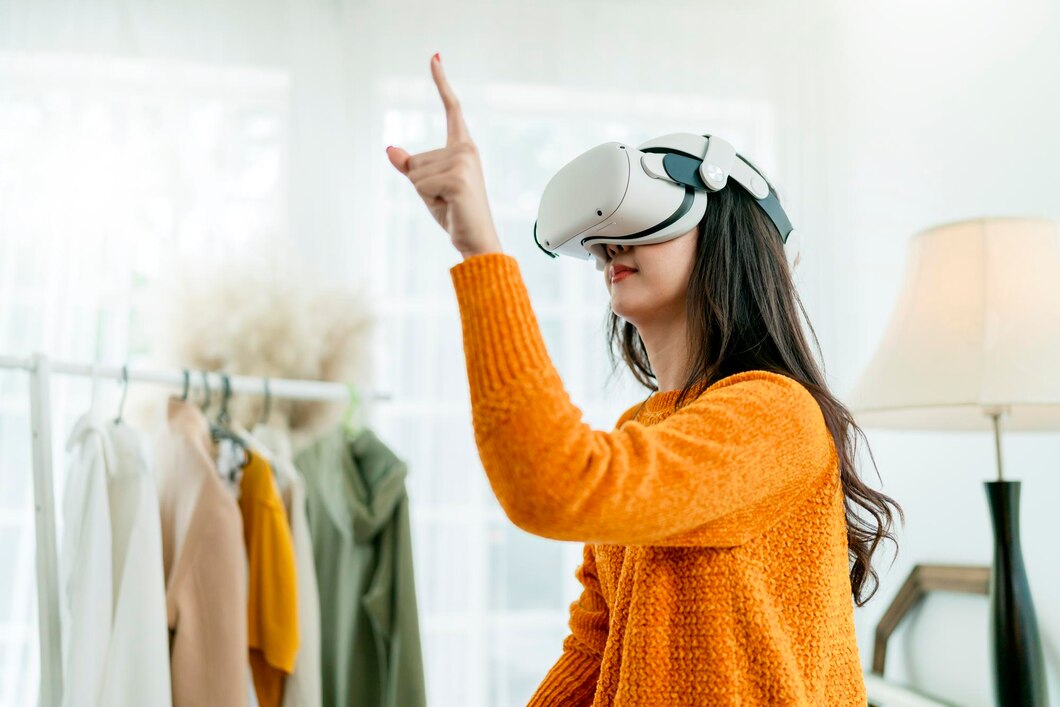How AI is Changing the Future of Fashion Retail
Artificial intelligence (AI) is weaving its magic through the fashion industry. From personalised shopping experiences to sustainable practices, its impact is profound. For retailers eager to lead the pack, embracing AI is no longer a choice; it’s a necessity. This guide is your stylish roadmap, showing how to seamlessly integrate AI into your fashion business.

Artificial intelligence (AI) is weaving its magic through the fashion industry. From personalised shopping experiences to sustainable practices, its impact is profound. For retailers eager to lead the pack, embracing AI is no longer a choice; it’s a necessity. This guide is your stylish roadmap, showing how to seamlessly integrate AI into your fashion business. Elevate efficiency, boost customer satisfaction, and champion sustainability as you dance into the future of retail.

Step 1: Understand the Role of AI in Fashion Retail
Before adopting AI, it’s crucial to understand its impact on different aspects of fashion retail:
- Personalised Shopping – AI-driven virtual stylists and recommendation engines offer customers tailored outfit suggestions.
- Trend Prediction – AI analyses vast data sources to forecast emerging fashion trends.
- Inventory Management – AI optimises stock levels, reducing overproduction and waste.
- Sustainable Fashion – AI helps develop eco-friendly materials and minimise textile waste.
- Smart Fashion Innovations – AI integrates with wearable tech and innovative fabrics for enhanced functionality.
- Marketing & Customer Engagement – AI chatbots and visual search tools improve shopping experiences.

Step 2: Leverage AI for Personalized Shopping
1. AI-Powered Virtual Stylists
AI virtual stylists give personalised suggestions. They consider what you like, what you’ve bought, and your social media interactions. Zalando’s AI assistant and ASOS’s recommendation engine help shoppers find their ideal outfit.
2. Augmented Reality (AR) & Virtual Try-Ons
Many retailers now use AR fitting rooms. This lets customers see how clothes look on them before they buy. AI checks body measurements and recommends the best-fitting items, reducing returns and boosting customer satisfaction.
Step 3: Use Predictive Analytics for Trend Forecasting & Inventory Management
1. AI for Trend Forecasting
AI predicts fashion trends by analysing social media, online searches, and how people shop. Heuritech uses machine learning to spot new trends, which helps brands create collections before competitors.
2. AI in Demand Forecasting & Inventory Optimization
AI inventory management systems look at past sales, weather, and current demand to improve stock levels. This minimises waste and ensures that retailers don’t overproduce or understock popular items.
Step 4: Adopt AI for Sustainable Fashion Practices
1. AI-Designed Eco-Friendly Fashion
Sustainability is a significant focus in fashion. AI helps designers select sustainable materials and minimise fabric waste. Brands like H&M and Adidas use AI to create eco-friendly collections with minimal environmental impact.
2. Reducing Textile Waste
AI improves textile cutting efficiency, ensuring minimal fabric wastage during production. Additionally, AI-powered resale platforms like ThredUp connect second-hand clothing with new buyers, extending product life cycles.
Step 5: Integrate AI with Smart Fashion Innovations
1. Smart Fabrics & Wearable Tech
AI-driven bright fabrics, such as Google’s Jacquard project, integrate technology into fashion. Wearables with biometric tracking, temperature regulation, and connectivity redefine how fashion meets functionality.
2. AI in Custom-Fit & Bespoke Fashion
Custom-fit fashion is gaining popularity, with brands like Uniqlo and Nike using AI to tailor garments based on consumer preferences. AI-driven personalisation allows customers to co-create unique designs that match their style.
Step 6: Enhance Marketing & Customer Engagement with AI
1. AI-Powered Visual Search
Consumers can now search for clothing by uploading images instead of typing descriptions. Platforms like Pinterest and ASOS use AI-powered visual search tools to instantly help customers find similar products.
2. Chatbots & AI-Driven Customer Service
AI chatbots improve customer service by providing instant support, answering questions, and handling complaints. Retailers like H&M and Sephora use AI chatbots to assist customers 24/7, enhancing engagement and satisfaction.
Step 7: Overcome AI Implementation Challenges
While AI offers numerous benefits, businesses must navigate challenges to maximise its potential:
- High Costs – AI implementation requires significant investment, which may be difficult for small businesses.
- Data Privacy & Security – Customer data collection must comply with regulations like GDPR to avoid legal issues.
- Quality of Data – AI systems rely on accurate, unbiased data for effective decision-making. Poor data quality can lead to incorrect recommendations.
Step 8: Prepare for the Future of AI in Fashion
AI in fashion retail will continue evolving with new trends:
- Digital Fashion & Virtual Clothing – AI-generated fashion exists only in the digital realm, reducing material waste.
- AI & Blockchain for Transparency – AI combined with blockchain ensures traceability in the fashion supply chain.
- Hyper-Personalized AI Assistants – AI assistants will provide deeper personalisation, curating entire wardrobes based on lifestyle and real-time factors.
Pro Tip: Leverage AI-powered trend forecasting to stay ahead of competitors. Machine learning analyzes social media, search trends, and sales data, helping retailers predict and produce what customers will want next—before they even know it.
Quick Guide
- Personalized Shopping: AI virtual stylists & recommendation engines enhance customer experience.
- Trend Forecasting: AI analyzes data to predict future fashion trends.
- Inventory Optimization: Prevent overstock & understock with AI-driven demand forecasting.
- Sustainable Practices: AI helps reduce textile waste & promotes eco-friendly fashion.
- Smart Fashion: AI-integrated wearables & custom-fit fashion elevate innovation.
- Marketing Boost: AI chatbots & visual search improve customer engagement.
Important: AI is revolutionizing fashion retail—brands that embrace AI-driven insights, personalization, and sustainability will dominate the industry. Stay ahead by integrating AI-powered tools today.
FAQs
Q1: How can small fashion retailers afford AI integration?
AI implementation can be expensive. However, cloud-based AI services and third-party solutions offer cheaper options. Retailers can start small with AI chatbots or trend-forecasting tools before scaling up.
Q2: Will AI replace human designers and retail staff?
AI enhances creativity and efficiency but doesn’t replace human creativity. Designers are key in understanding trends and artistic vision. AI helps by making decisions based on data.
Q3: How does AI improve sustainability in fashion?
AI helps reduce textile waste, optimises fabric use, and recommends eco-friendly materials. It also enhances supply chain transparency, ensuring ethical sourcing and minimal environmental impact.
Q4: What are some real-world examples of AI in fashion retail?
Brands such as H&M, Adidas, and Uniqlo use AI to promote sustainable fashion. Nike uses AI to create custom shoe designs. ASOS relies on AI for its recommendation engines.
Q5: How can AI help reduce fashion waste?
AI-driven demand forecasting stops overproduction. AI-powered resale platforms like ThredUp support second-hand fashion, helping extend the lifecycle of clothing.

Embracing AI: The Future of Fashion Retail
AI is shaking up the fashion retail scene in remarkable ways. It delivers more brilliant shopping experiences, sharpens trend predictions, and champions sustainability. You can elevate customer satisfaction and streamline operations by weaving AI into your business fabric. Stay ahead of the curve in this fast-paced fashion world. Embrace AI now, and weave the future of fashion retail to perfection!